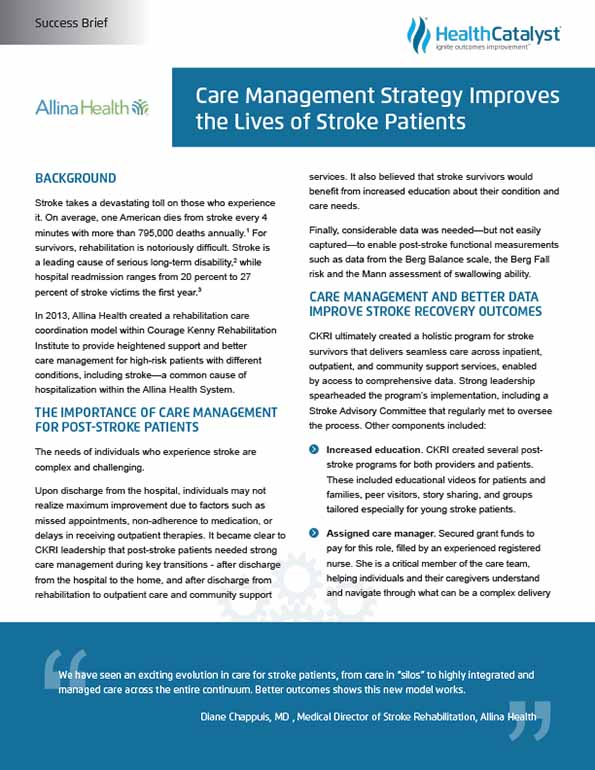Allina Health’s Courage Kenny Rehabilitation Institute developed a comprehensive care program for individuals who have experienced a stroke, integrating inpatient and outpatient services. Utilizing its data analytics platform to identify high-risk patients, the organization demonstrated the model’s effectiveness within a year, achieving $350,000 in cost savings and significantly improving patient outcomes and lives.
Stroke takes a devastating toll on those who experience it. On average, one American dies from stroke every 4 minutes with more than 795,000 deaths annually.1 For survivors, rehabilitation is notoriously difficult. Stroke is a leading cause of serious long-term disability,2 while hospital readmission ranges from 20 percent to 27 percent of stroke victims the first year.3
In 2013, Allina Health created a rehabilitation care coordination model within Courage Kenny Rehabilitation Institute to provide heightened support and better care management for high-risk patients with different conditions, including stroke—a common cause of hospitalization within the Allina Health System.
The needs of individuals who experience stroke are complex and challenging.
Upon discharge from the hospital, individuals may not realize maximum improvement due to factors such as missed appointments, non-adherence to medication, or delays in receiving outpatient therapies. It became clear to CKRI leadership that post-stroke patients needed strong care management during key transitions – after discharge from the hospital to the home, and after discharge from rehabilitation to outpatient care and community support services. It also believed that stroke survivors would benefit from increased education about their condition and care needs.
Finally, considerable data was needed—but not easily captured—to enable post-stroke functional measurements such as data from the Berg Balance scale, the Berg Fall risk and the Mann assessment of swallowing ability.
CKRI ultimately created a holistic program for stroke survivors that delivers seamless care across inpatient, outpatient, and community support services, enabled by access to comprehensive data. Strong leadership spearheaded the program’s implementation, including a Stroke Advisory Committee that regularly met to oversee the process. Other components included:
Within a year, Allina was able to prove the value of this new care model for stroke through cost savings and, most importantly, through actual lives saved.
“We have seen an exciting evolution in care for stroke patients, from care in “silos” to highly integrated and managed care across the entire continuum. Better outcomes shows this new model works.”
- Diane Chappuis, MD, Medical Director of Stroke Rehabilitation, Allina Health
With such impressive results, Allina plans to expand the Stroke Care Management Program and improve outcomes for more patients. Incidentally, this program has laid the groundwork for learning how to produce these outcomes at the lowest possible cost—an essential capability in the new era of value-based reimbursement.
1., 2. Mozzafarian, D., Benjamin, E.J., Go, A.S., Arnett, D.K., Blaha, M.J., Cushman, M.,…Turner, M.B. Heart disease and stroke statistics—2015 update: a report from the American Heart Association. Circulation. 2015;131(4):e29–322.
3. Sacco, R.L., Hauser, W.A., & Mohr, J.P.. Hospitalized stroke in blacks and Hispanics in northern Manhattan. Stroke. 1991;22:1491–1496.




